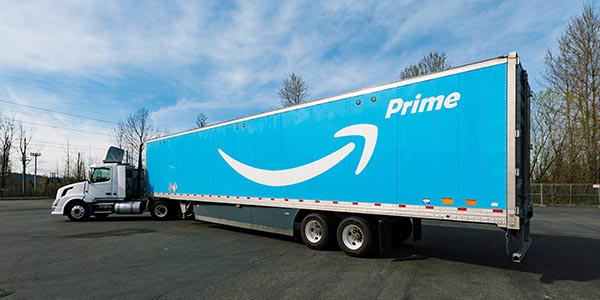Amazon pushes dedicated truck operation; will it suck oxygen out of the driver room?

E-tailer eyeing partnerships with fleets of three or more trucks to haul between DCs.
Is Amazon.com Inc. draining the commercial truck driver pool?
Yes, according to a top motor carrier executive, who told one of its best shippers—a customer prepared to tender abundant and predictable traffic at highly compensatory rates—that it would only agree to a 90-day contract extension once it comes up for renewal June 15.
According to a person familiar with the matter, the carrier executive said drivers who would normally be available for recruitment were instead migrating to Amazon. The executive added that equipment and drivers would be diverted to the spot, or non-contract, market, which remains sizzling hot and appears to be a better deal for the carrier than signing static contracts while pricing remains so dynamic, the person said. Neither the executive, the carrier, nor the shipper were identified.
At first blush, the executive's rationale appears absurd. Amazon has, by one estimate, a paltry 300 power units, a fleet size that would hardly move the needle. By contrast, Green Bay, Wis.-based Schneider Inc. and Omaha-based Werner Enterprises Inc., both of which are big truckload carriers and logistics providers, have 10,800 and 7,300 units, respectively. FedEx Freight, the less-than-truckload (LTL) unit of Memphis-based FedEx Corp., has more than 20,000 tractor-trailers. In addition, these days it's fashionable to blame the Seattle-based e-tailer for every dislocation occurring in American industry, some of which, to be sure, Amazon has been responsible for.
But as with everything at Amazon, there is more going on than meets the eye. For example, in March the company was at the huge Mid-America Truck Show in Louisville, Ky., to recruit fleets to join its dedicated trucking operation. The business, which goes by the name of Amazon.com.dedc.LLC, wants fleets that have at least three trucks, their own operating authorities, and drivers who can operate twin-trailers to haul goods in the company's distribution center network, Amazon said in literature distributed at the show, known in the trade as MATS.
Amazon has 328 U.S. facilities, of which 182 are classified as DCs, hubs, delivery centers, or inbound and outbound sortation facilities, according to estimates from consultancy MWPVL International Inc., which tracks Amazon's physical distribution network.
In his pitch, Greg Sellers, program manager of line-haul distribution, said the company is "working with line-haul providers of all sizes" and will "continue to recruit for trucking companies to join our team." The unit offers a "steady, high volume of freight, the ability to plan ahead, automatic weekly direct-deposit settlements, as well as a roster of lifestyle features that trucking-company employees really seem to like," Sellers wrote. He didn't elaborate on the specific amenities.
All the freight is of the "drop and hook" variety, meaning a driver drops off a full or empty trailer at a specified location and moves on with another trailer, either empty or full, without waiting for the dropped-off equipment to be unloaded. Drivers can be home the same day or, at worst, the next day, according to Sellers. "There's work for singles and teams" as long as the drivers are employees of the trucking company, Sellers said.
Drivers need only bring the power units to the engagement, Sellers said. That is of little surprise, since Amazon has bought or leased thousands of trailers in the past few years in readiness for what has long been believed to be a massive rollout of a nationwide transport and logistics network. The project's main goal is supporting the two-day delivery commitments of its popular "Amazon Prime" service, which promises nearly unlimited deliveries for a $119 annual fee or a $12.99 monthly charge.
In April 2017, Amazon joined a portal that screens, or "on boards," prospective drivers to ensure they have the proper operating and insurance documentation. At the time, Amazon was looking to recruit as many as 30,000 owner-operator drivers.
Amazon, which did not respond to an e-mail request for comment, currently moves between 5 and 10 percent of its orders through its own network. The rest is outsourced to the U.S. Postal Service, Atlanta-based UPS Inc., FedEx, and an assortment of regional and local parcel delivery firms. With volumes growing at a double-digit quarterly clip, Amazon believes it needs to supplement its carrier relationships with its own network to meet its delivery pledges.
Amazon's traffic growth is so astounding that, while it is likely to handle more of its own traffic in coming years, its delivery partners will probably not see any drop-off in their own volumes.
No comments:
Post a Comment